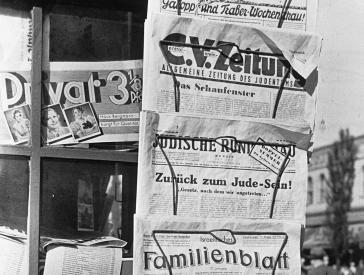"Radical Jewish Culture. The New York Music Scene Since the 1990s"
Press Invitation to the Exhibition Opening
Press Release, Thu 24 Mar 2011
"Radical Jewish Culture" is an avant-garde Jewish music movement that developed in the New York underground scene at the beginning of the 1990s. Musicians such as John Zorn, David Krakauer, Marc Ribot, Anthony Coleman, and Frank London passionately explored the possibilities for a new form of Jewish music, emancipating themselves from conformity and inconspicuousness. Their music blended free jazz forms with klezmer improvisations, experimental music with rock, blues, and punk. The exhibition "Radical Jewish Culture" (8 April to 24 July 2011) presents this music scene through audiovisual documents, lots of music samples, and primarily unpublished material. We cordially invite you to attend the press conference and opening on Thursday 7 April 2011.
- Kontakt
-
Press office
T +49 (0)30 259 93 419
presse@jmberlin.de
- Address
Jewish Museum Berlin Foundation
Lindenstraße 9–14
10969 Berlin
We cordially invite you to attend the press conference and opening on Thursday 7 April 2011.
Press Conference
| Press Conference | 7 April 2011, midday |
|---|---|
| Exhibition preview | from 11 am |
| Where | Old Building, first level, Education Room |
| With | Cilly Kugelmann, program director, Jewish Museum Berlin Mathias Dreyfuss, exhibition curator, Musée d'art et d'histoire du Judaïsme, Paris The composer and artist Arnold Dreyblatt will also attend. |
Opening Program
- Words of welcome
- The exhibition
- Music
Cilly Kugelmann, program director, Jewish Museum Berlin
Mathias Dreyfuss, exhibition curator
Paul Brody, trumpeter and composer
| Opening | 7 April 2011, 7 pm |
|---|---|
| Where | Glass Courtyard, ground level |
| Admission | free |
The Exhibition "Radical Jewish Culture"
"Festival for Radical New Jewish Culture" was the name the New York composer and saxophonist John Zorn gave his section of the program at the "Art Projekt ‘92" music festival in Munich. He invited musicians of different genres, among them greats from the New York underground scene such as Lou Reed and John Lurie. Amongst the New York musicians, the festival provoked a collective exploration of their Jewish identity. A series of festivals ensued in New York and European towns such as at the Künstlerhaus Tacheles in Berlin in 1997.
The special exhibition "Radical Jewish Culture," curated in Paris where it was shown last year, shows how this music scene developed through numerous music samples, concert clips, and largely unpublished archival materials from the musicians involved. On show are music books, pictures, and books belonging to the musicians and works of art that were sources of inspiration for costumes and LP covers. The key figures of this music scene have their say in interviews: John Zorn, Anthony Coleman, Marc Ribot, David Krakauer, Shelley Hirsch, Elliott Sharp, Roy Nathanson, and Frank London.
In Search of "New Jewish Music"
In eight chapters, the exhibition provides an overview of this prolific music decade of Radical Jewish Culture and its precursors: an introduction to the historical roots of klezmer in Eastern Europe, its further development through the Jewish immigrants in the USA, its dismissal as "ghetto music" in the post-war era, and the klezmer revival of the 70s and 80s.
The heart of the exhibition is the Festival for Radical New Jewish Culture in Munich that gave the exhibition its name. In preparation for the festival, John Zorn and Marc Ribot composed a declaration inquiring about the Jewish part in the emergence of New York’s alternative music scene. A highlight in Munich was the premiere performance of John Zorn’s composition "Kristallnacht" – a very personal interpretation of the history of Jews in the 20th century. A film clip of the disturbing performance, throughout which the audience was asked not to leave the room, is shown in the exhibition with notes and documents from John Zorn’s preparatory phase. Through the festival and the "Kristallnacht" performance, the musicians involved made a political statement against the anti-Semitic movement that was gaining strength in Germany and Eastern Europe.
In Search of Traces on the Lower East Side
Two exhibition chapters present the special role of New York, in particular the Lower East Side, in the development of Radical Jewish Culture. In search of their Jewish identity, video artists such as Chantal Ackerman and Ken Jacob and musicians like Anthony Coleman explore the local and social history of the district where Jewish immigrants have left their mark since the end of the 19th century. The political involvement of many artists from the alternative and Jewish music scenes is shown through the example of the Knitting Factory in New York and the surrounding activities.
John Zorn’s mammoth compositional project "Masada" – named after the fortress in the Judean Desert – is the theme of a further exhibition chapter. Stemming from his search for a "grammar" of new Jewish music and modelled after the number of commandments in the Torah, "Masada" consists of 613 pieces of music. Alongside music samples, further exhibits include a parchment work of art by the American artist Wallace Bermann and his collage film "Aleph," for which Zorn created musical improvisations. The collage was also a source of inspiration to Zorn for a series of "Masada" covers.
The exhibition was redesigned for its display at the Jewish Museum Berlin. The KatzKaiser office chose the form of a hollowed-out black corpus as a spatial metaphor to represent the musicians’ inner quest. This theme sweeps through the exhibition rooms – audio terminals and mini cinemas in the golden corpus interior invite visitors to immerse themselves in the music.
An exhibition by the Musée d’art et d’histoire du Judaïsme, Paris at the Jewish Museum Berlin.
Generously supported by the Wall AG.
Further information on the exhibition can be found at: www.jmberlin.de/radical




